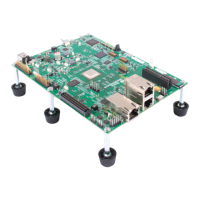Instrumentation Performance
Instrumentation 3-15
3.4 Instrumentation Performance
When all implicit DSP/BIOS instrumentation is enabled, the CPU load
increases less than one percent in a typical application. Several techniques
have been used to minimize the impact of instrumentation on application
performance:
❏ Instrumentation communication between the target and the host is
performed in the background (IDL) thread, which has the lowest priority,
so communicating instrumentation data does not affect the real-time
behavior of the application.
❏ From the host, you can control the rate at which the host polls the target.
You can stop all host interaction with the target if you want to eliminate all
unnecessary external interaction with the target.
❏ The target does not store implicit statistics information unless tracing is
enabled. You also have the ability to enable or disable the explicit
instrumentation of the application by using the TRC module and one of
the reserved trace masks (TRC_USER0 and TRC_USER1).
❏ Log and statistics data are always formatted on the host. The average
value for an STS object and the CPU load are computed on the host.
Computations needed for RTA tool displays are performed on the host.
❏ LOG, STS, and TRC module operations are very fast and execute in
constant time, as shown in the following list:
■ LOG_printf and LOG_event: approximately 25 instructions
■ STS_add: approximately 10 instructions
■ STS_delta: approximately 15 instructions
■ TRC_enable and TRC_disable: approximately four instructions
■ LOG_printf and LOG_event: approximately 32 instructions
■ STS_add: approximately 18 instructions
■ STS_delta: approximately 21 instructions
■ TRC_enable and TRC_disable: approximately six instructions
❏ Each STS object uses only eight or four words of data memory, for the
C5000 platform or the C6000 platform, respectively. This means that the
host always transfers the same number of words to upload data from a
statistics object.
❏ Statistics are accumulated in 32-bit variables on the target and in 64-bit
variables on the host. When the host polls the target for real-time
statistics, it resets the variables on the target. This minimizes space
requirements on the target while allowing you to keep statistics for long
test runs.
❏ You can specify the buffer size for LOG objects. The buffer size affects
the program’s data size and the time required to upload log data.

